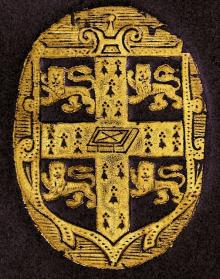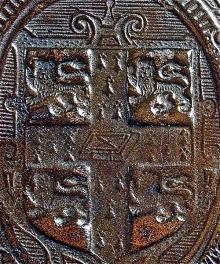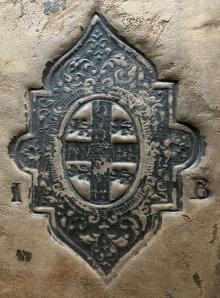Cambridge University Press (16th century) N/A
Stamp 1 was used as a printer's device by Thomas Thomas, University Printer at Cambridge on the titlepages of two books printed in 1584. The books are Bright, Timothy. In physicam Gulielmi Adolphi Scribonii, post secundam editionem animadversiones. Cambridge, 1584; and La Ramée, Pierre. P. Rami dialecticae libri duo. Cambridge, 1584. In addition to this use as a printing block it was used on a number of bindings often within an elaborate arabesque frame. Though the stamp may have been one of the 3 "marks" in Thomas Thomas's inventory, it is unlikely that Thomas Thomas bound books. The binding tools in the inventory to his will being sufficient only for the sewing of pamphlets in wrappers.
Stamp 2, though very similar to 1, is never found with it, but is usually paired with a stamp of the Tudor royal arms with an imperial crown and the Garter. This pair of stamps are also found in an arabesque frame, similar to but not the same as that found with 1. Mr H.M. Nixon told me privately that he believed that these stamps belonged to a London binder.
Stamp 3 was used by Thomas Thomas's successor, John Legate, as a device on a small Latin grammar, Nova et expedita via comparandae linguae Latinæ. with the imprint `Ex officina Johannis Legatt, florentissimæ Academiæ Cantabrigiensis Typographi' [ca 1590]. There is a copy in the Bodleian Library, Oxford (R.22.Art.Seld(5)). It also occurs as a binding stamp in a third arabesque frame similar to but not identical with those used with stamps 1 and 2. In this stamp the lions are shown as passant not passant gardant. The arms were granted to the University in 1573 by Robert Cooke, Clarenceux King of Arms. There is an inaccuracy in the grant, for though the illustration in the original patent in the University Archives shows the lions as gardant the text describes the arms as "Gules sur ung croix dermines entre quatre Lions passant d'or ung Livre de gules". The accepted form for the lions is gardant.
I wrote an article `Thomas Thomas, Printer to the University of Cambridge 1583 8. Part II' in Transactions of the Cambridge Bibliographical Society iv,339 362 (1968). In it I attributed the bindings with Stamps 1 3 to Thomas Thomas. The article contains a number of inaccuracies in its account of the bindings, including the transposition by the printer of the captions of Centrepiece 1 in frame 1 and Centrepiece 2 in frame 2. Despite the similarities in size between the three stamps and their frames, the stamps always occur with the same frames, and it seems clear that three separate binders are concerned. Stamps 1 and 3 were probably owned by Cambridge binders, as their use by two of the University Printers suggests. Stamp 2 and the associated block of the Elizabethan royal arms, may well have belonged to a London binder as Nixon believed. The binder who used stamp 1 and its associated frame seems to have had difficulty with the impression of his stamps. Only on the 1618 MS of Scott's Foundation of the University of Cambridge is the stamp shown to advantage.
Stamp 1 is illustrated in R.B. McKerrow. Printers' & publishers devices in England & Scotland 1485 1640. London: Bibliographical Society, 1913. No 234, and rather better in David McKitterick. Four hundred years of University printing and publishing in Cambridge 1584 1984. Catalogue of the exhibition in the University Library Cambridge. Cambridge, 1984 p.18, where stamp 3 is also illustrated. McKerrow does not include Stamp 3.




